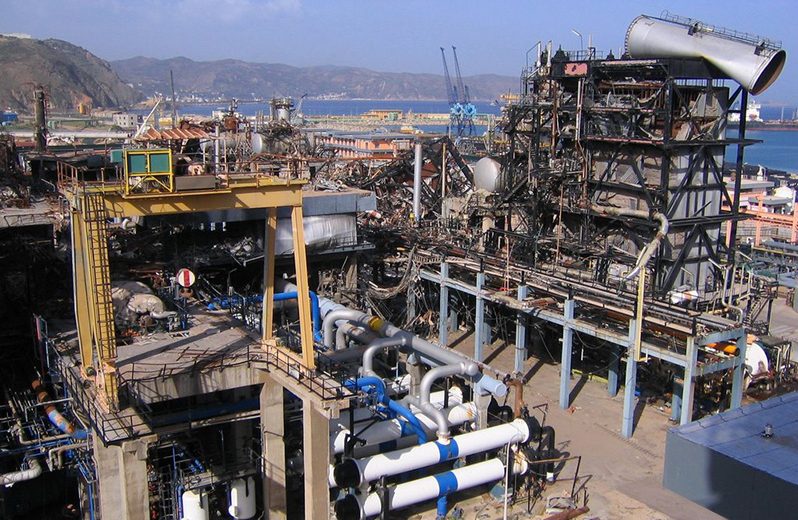In 1956, the enormous Hassi R’Mel gas field was discovered in Algeria, with gas production commencing in 1961. The field is not only the largest in Algeria, but also one of the largest in the world. SONATRACH, Algeria’s state-owned oil and gas company, is Africa’s first hydrocarbon group and the pioneer in LNG technology. In 1964, the company started production at La Camel LNG (Arzew – GL4Z), the first LNG plant operational in the world. Shortly thereafter, in 1972, the company launched the Skikda LNG plant (GL1K) to export LNG, Ethane, Propane, Butane and Natural Gasoline. The LNG complex was erected at Skikda, a city in north-eastern Algeria on the Mediterranean Gulf of Stora, 500 km east of Algiers. The 227 acre site is part of the Skikda Industrial Zone, which spans over a massive 3,100 acre area and houses 7 major industrial complexes.
The plant was constructed in 3 phases, with the first phase involving 3 trains of approximately 1 MMTPA capacity each (dubbed Skikda GL1K – units 10, 20 & 30). Technip was contracted to build the plant using the TEAL liquefaction process. In 1981, the second phase of development at Skikda was completed, after experiencing 6 years of delay. Prichard Rhodes were contracted to construct 3 trains each (dubbed Skikda GL2K – units 40, 5P & 6P), employing Prichard’s PRICO technology. The 1 MMTPA capacity train 40, was built adjacent to train 30 and shared the existing utilities. The other 2 trains, of capacity 1.25 MMTPA each, were built at the opposite end of the facility, separated from the first 4 trains by the storage tanks. In the 1990’s, all the 6 trains of the plant was revamped under a modernisation programme, with the production capacity of the facility enhanced to 7.68 MMTPA.
On January 19, 2004, a massive explosion occurred at train 40 during routine boiler maintenance, claiming 23 lives and injuring 74 others. The explosion triggered an intense fire, as it ignited a vapor cloud of leaked fuel above the plant. The flames completely destroyed trains 20, 30 & 40, raised several buildings to the ground, as well as partially damaged the loading facilities. Trains 10, 5P and 6P were subsequently restartedlater in the year. The incident was the worst accident recorded in the history of LNG. In 2005, Sonatrach initiated a rebuild operation, which involved demolition of the damaged trains and the reconstruction of 1 mega train of 4.5 MMTPA capacity, using Air Products’ process technology. KBR (Kellogg Brown & Root International) was awarded a $2.8 billion contract to construct the largest LNG train ever built in Algeria. The plant became operational in 2013.
The Skikda Industrial Zone is a premier industrial site of Algeria, providing employment to almost 12,000 people. By 2030, Sonatrach aims to add revenue of $68 billion and contribute it equally between national wealth and renewal of reserves, production capacity, staff training and development of expertise in the Company. The company funds and sponsors various scientific, economic, sports and cultural projects in the country. The SONATRACH-Tassili Foundation concentrates on the protection of the environment, animal and plant biodiversity and tangible and intangible cultural heritage.
OWNERSHIP (Equity %)
| Sonatrach | 100.00% |
General Data
| Estimated Capital Cost (USD) | 2.8 B per train |
| Plant Type | Onshore Stick-built |
| Plant Stage | Train 1 – Operating Train 2 & 3 – Non-operational |
| Final Investment Decision (FID) Year | 2007 (Rebuild) |
| FEED Contractor | KBR |
| EPC Contractor | KBR (originally Technip) |
| No. of Trains / capacity | 1 (2 trains demolished) / 1.0 MMTPA each train |
| Production Start Year | Train 1 & 2 – 1972 Train 3 – 1973 Train 1 Rebuild - 2013 |
| Products | LNG, Ethane, Propane, Butane, Gasoline |
| Gas Type | Non-associated Gas (NAG) |
Technical Data
| Cooling Media | Seawater |
| Liquefaction Technology | Two-pressure TEALARC |
| Refrigeration Train Details: | |
| Mixed Refrigerant (MR) Train | |
| Driver | CEM-BST Steam Turbine (107,000 bHp) Single cylinder, condensing, double flow low pressure blading |
| Low Pressure (LP) MR Compressor | CEM-BST Axial Compressor |
| High Pressure (HP) MR Compressor | CEM-BST Axial Compressor (Variable Pitch Blades) |
| Notes | CEM – Compagnie Électro-Mécanique BST – Brown Boveri – Sulzer Turbomaschinen AG |
Refrigeration Train Configuration

Key Facts
- The GL1K plant is the fourth plant in the world and the first to deliver multiple finished products having completely controlled commercial specifications. In addition to LNG, the plant can deliver 165,000 Ton/year Ethane, 208,000 Ton/year Propane, 171,000 Ton/year Butane and 109,000 Ton/year Gasoline.1
- The three-train modular design was based on a proprietary refrigerating fluid process. Each unit showcased 107,000 bHp of power, its own control room and complete independent from the others.1
- Operating experience from La CAMEL LNG allowed Skikda to optimise overall efficiency through selection of appropriate technical solutions. The plant design focussed on minimizing the use of rotating equipment, offering preference to static option, if available. A single compressor was selected instead of a combination of multiple units employed at La CAMEL.1
- The GL1K used 30 spool-wound cryogenic exchangers the largest having a heat transfer surface area of 140,000 ft2 and a weight of 240,000 Ib.1
- Skikda GL1K exported LNG to France, Spain and USA.2
- In 1972, when GL1K began operations at Skikda, it was the largest LNG plant in the world. The LNG plant employed the Tealarc process, while the ethane and LPG extraction facilities used the Prico process. 3
- In the 1990’s, revamping and expansion work was initiated under Sofregaz/GdF management. However, the work was deemed unsatisfactory and the contract was subsequently terminated in March 1997. Kellogg was hired thereafter to complete the operation within a year.3
- In 1972, Skikda became the first plant in the world to extract LPG and ethane and commercialise it separately from LNG. A petrochemicals plant in the vicinity acquired the ethane produced at Skikda. 4
- The Teal process employed at GL1K, achieves the temperature gradient using a single refrigerant fluid containing Nitrogen and hydrocarbons of the same nature as those contained in the natural gas to be liquefied. This refrigerant fluid operates at 4 cooling stages, or cascade, obtained by four successive expansions. After the last expansion, the refrigerant fluid comes back to the compressor at two different suction pressures (5,1 bar and 0,6 bar).5
- On January 19, 2004, an explosion at the Skikda LNG plant consumed 23 lives and left 74 injured. The explosion destroyed three out of the six liquefaction trains, damaged a nearby power plant and resulted in the shutdown of a 335,000 bbl per day refinery. Some damage was also caused to the neighbouring industrial facilities. Initial reports suggested a fault in one of the boilers, however, investigations indicated that a large vapour cloud of hydrocarbons released from a pipe, was ignited during the accident. Train 6P subsequently re-started in May 2004, while trains 5P and 10 resumed operations in September 2004. Trains 20, 30, and 40 were destroyed in the incident, together accounting for approximately 50% of the capacity of the facility. The damage was estimated to have cost approximately $690 million after adjusting inflation till 2018.6,7
- Air Products was contracted to supply its proprietary process technology and main cryogenic heat exchanger for the rebuilt plant at Skikda. The contract included APCI’s proprietary propane pre-cooled mixed refrigerant liquefaction process technology, with the Split MRTM refrigeration equipment configuration, and an MCR® main cryogenic heat exchanger. 8
Source:
1. Bourguet J.M. ‘Cryogenic Technology and Scaleup Problems of Very Large LNG Plants’, Part of the Advances in Cryogenic Engineering book series (ACRE, volume 18), Page 9-26, August 1972
2. Benali A. ‘The Renovation Of A Liquefaction Complex: Sonatrach Experience—Algeria’, 13th International Conference & Exhibition on Liquefied Natural Gas (LNG 13), Seoul, South Korea, May 2001
3. ‘Algeria – The LNG Export Plants’, The Free Library Website, 1999
4. Bramoullé Y. et al. ‘LNG Quality And Market Flexibility Challenges And Solutions’, 14th International Conference & Exhibition on Liquefied Natural Gas (LNG 14), Doha, Qatar, March 2004
5. Ainouche A. ‘Optimization Of Skikda LNG Plant Operation Using A Mixed Non-Linear Programming Model’, 14th International Conference & Exhibition on Liquefied Natural Gas (LNG 14), Doha, Qatar, March 2004
6. ‘Explosion at Sonatrach’s Skikda LNG Export Plant’, Plant Maintenance Website, 22 January 2004
7. ‘Report sheds new light on LNG blast in Algeria’, Alexander’s Gas & Oil Connections
8. ‘Air Products to Provide Proprietary Technology for Largest LNG Facility in Algeria’, Killajoules website





















































